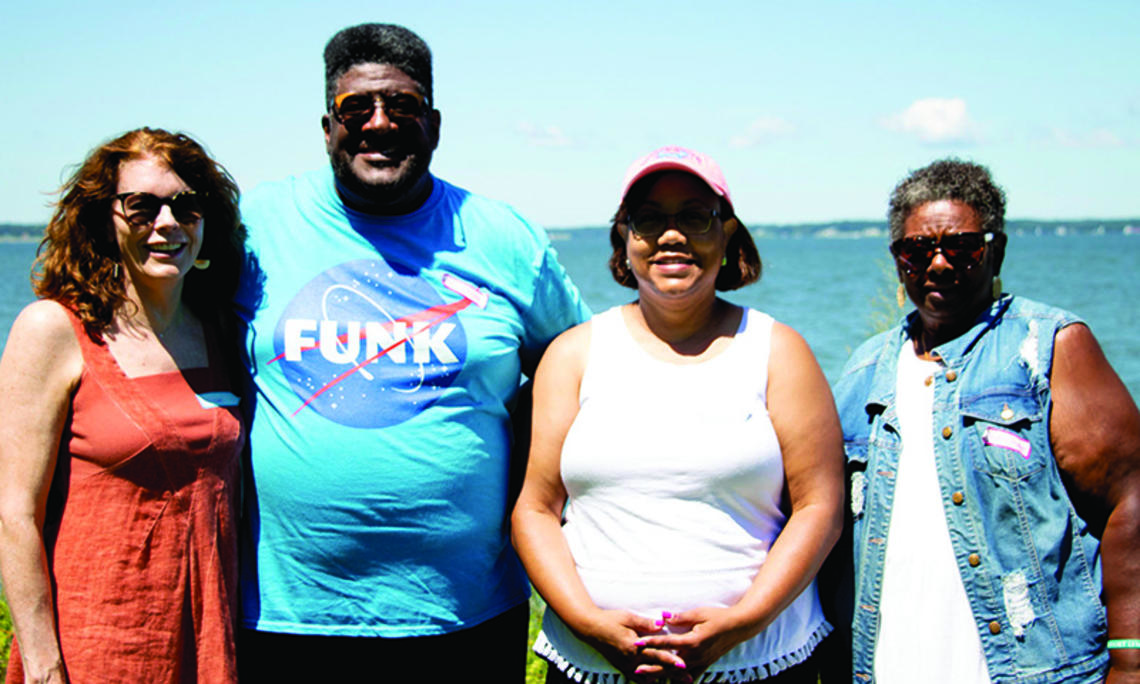Allison Thomas ’78 Probes History of Virginia Island’s Black Community
Thomas is working with writer Maria Sharp Montgomery, a descendent of those whom Thomas’ family enslaved

When Allison Thomas ’78 introduces herself, she does so like this: “My name is Allison and I descend from enslavers dating back to Colonial Virginia.” This usually shocks people, but she doesn’t care. Thomas wants to normalize revealing these stories, both through small interactions and big projects, including one she started working on in 2015 when she found proof of her family’s true history in an ancestor’s diary.
She and writer Maria Sharp Montgomery, along with Our Black Ancestry, a nonprofit, launched the Gwynn’s Island Project, which has unraveled the history of a Virginia island located on the western shore of the lower Chesapeake Bay. They’re connected because Montgomery is a descendent of those whom Thomas’ family enslaved. Together, the duo has been telling this story and proving the existence of the island’s once thriving Black community.
“We’re not responsible for that history, but I am responsible for sharing it,” Thomas says.
When asked if she was aware of her family’s history of enslavement, Thomas says, “I was, and I wasn’t.” She knew that her family had a significant past in Mathews County, and that her seventh great-grandfather died the richest man in Virginia, with 300,000 acres of land and 10 million British pounds.
“The story that I grew up with was that he had 16 children and gave them each a piece,” she says. That the majority of his wealth also came from 1,000 enslaved people was left out. “Somehow we managed to make those enslaved people disappear.”
In 2015, Thomas joined an aunt, uncle, and her grandparents in going through letters written between 1820 and 1920 that had been stored in an attic. That’s where, along with transcriptions of those letters, she also found her great-great-great grandmother’s Civil War diary, which listed 40 enslaved people, with a dollar value written next to each name.
Thomas asked her uncle why no one told her. He assumed she knew. “Of course, our family continued to enslave people until they weren’t allowed to,” she recalls him saying. Thomas started posting letters and documents to Ancestry.com, which is how Montgomery found her, and they began collaborating on this project.
Enslaved people were brought to Gwynn’s Island in 1635 to work on corn and wheat plantations and in shipping. Most left after the Civil War, but some stayed. Some also ran away during the Civil War, and came back. By 1910, 25 Black families owned property on the island. They built homes, a church, a school, and cemeteries, and worked as fishermen and farmers. But pent-up white resentment eventually boiled over. A Confederate monument went up in 1912. In 1915, James H. Smith, Montgomery’s great-great-grandfather, was accused of assaulting a white man and found guilty. He was ordered to pay a fine and spent 30 days in jail. The white community considered this a light sentence. It was just one factor that led to increasing threats of violence, and pressure for Black residents of Gwynn’s Island to leave. It worked, and they were all gone by 1920, leaving behind their homes and farms. In 1924, the Richmond Times called the island a “White Man’s Paradise.”
To prove the existence of the island’s Black community — and that Black residents didn’t just up and leave for no reason — Thomas and Montgomery spent three years digging through census records, property deeds, bills of sale, and court records. “We kept uncovering new things,” she says. At first, the Gwynn’s Island Museum, which is run by Thomas’ cousin, who is also a descendant of the diary writer, “clung to the old narrative,” she says. But after rounds and rounds of conversations, the museum “came around 100%.”
Thomas and Montgomery wrote a new version of this history for the museum. Through Ancestry.com and Our Black Ancestry, they also created family trees to help connect descendants with their Gwynn’s Island ancestors. In August, they organized a second reunion for Black descendants of Gwynn’s Island, which drew 80 people. They’ve created a Facebook group and applied for a historical marker about the Black community to go in front of the island’s post office.
These events are joyful but also a paradox. “I can go visit my family cemetery, but we haven’t found the Black cemetery on the island, and we know there’s at least two,” Thomas says.
In addition to the project, Thomas works in the entertainment industry as a producer. The pandemic abruptly halted production, so she funneled her time and energy into the Gwynn’s Island Project and volunteering with Coming to the Table, a nonprofit that seeks to acknowledge and heal from the racial wounds of the past.
She adds, “All of us who descend from enslavers need to be talking about it because it’s part of our history.”










0 Responses